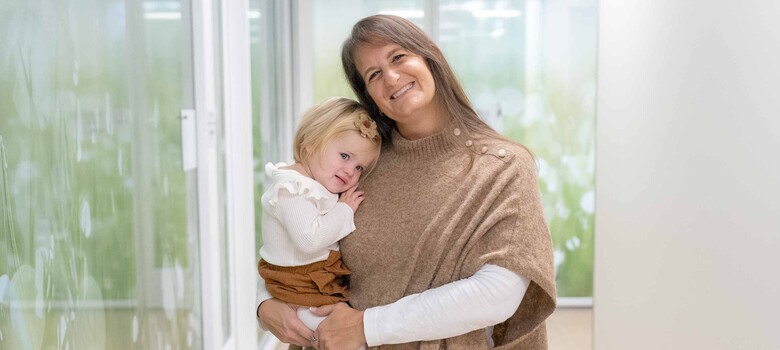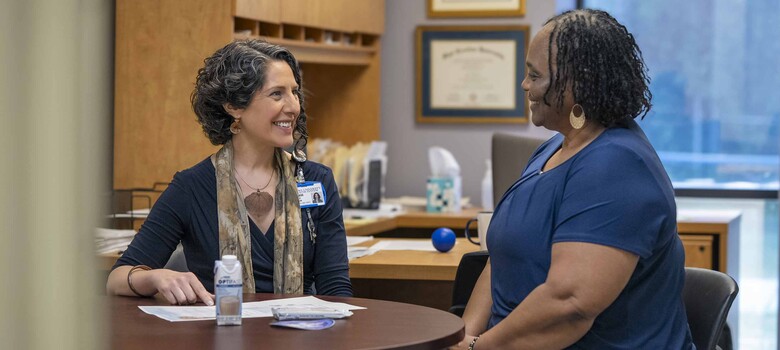 From the DukeHealth.org archives. Content may be out of date.
From the DukeHealth.org archives. Content may be out of date.
Scoliosis X-rays are safer with lower-radiation technology

Ellie Garman (photo: Gretchen Mathison)
New technology helps Duke doctors monitor Ellie Garman’s scoliosis (curvature of the spine) while reducing her X-ray radiation exposure.
Ellie, who's eight years old, wears a brace as part of her scoliosis treatment. “It hugs me like a turtle shell hugs a turtle,” she said of her brace. “So I call it my turtle shell.”
That turtle shell is part of a strategy her doctor, Duke pediatric orthopaedic surgeon Dr. Robert Lark, MD, is using to keep Ellie’s spinal curvature in check. “Scoliosis gets worse as you grow,” he said. “If spinal curves get to a certain point, they require surgery to halt the progression.”
To keep tabs on how well her brace is working, Ellie needs frequent X-rays. “She’s going to get X-rays until she’s 14 or 15 years old,” Dr. Lark said. “At least two times a year; more frequently if we have to change her brace.”
Those repeated X-rays come with a downside. “The high dose of radiation exposure has been shown to lead to increased risk of cancer, especially thyroid and breast cancer, in patients who have scoliosis,” Dr. Lark said. He noted that scoliosis in children is different than in adults and should be managed by pediatric surgeons who understand how children’s bodies deal with radiation.
New technology reduces X-ray radiation
To help monitor patients like Ellie while reducing their radiation exposure, Duke’s Lenox Baker Children's Hospital has acquired an EOS imaging system. “EOS is one-tenth the radiation dose of a conventional X-ray,” said Dr. Lark. “There’s even an ultra-low-dose protocol that can reduce radiation dose to one-fiftieth of a conventional X-ray.”
That’s good news to Ellie’s mom, Katie Garman. “The X-rays are really important for us to know what’s happening with Ellie’s back, but we wanted to try to do it as safely as possible,” she said. “Before Duke had the EOS system we went up to Virginia and had some X-rays taken there, where they had the EOS. So we were thrilled when Duke decided to make this investment for children in North Carolina, like Ellie, who are going to need a lot of X-rays.”
Benefits beyond reduced radiation exposure
In addition to being safer, the EOS system—which takes front and side views at the same time—gives Lark a better view of Ellie’s spine.
“The images are of a superior quality to conventional X-rays,” Dr. Lark said. “We can take the image while she’s standing, which shows us what Ellie’s spine looks like under weight-bearing conditions. We can shoot a conventional X-ray with her standing as well, but we’d have to shoot multiple images and stitch them together.” That means more radiation exposure for the patient. It also creates a seam where the images are stitched together, which disrupts the doctor’s view. Dr. Lark added, “With conventional X-rays, we’ve had to put breast shields on patients, which also limits how much we can see of the spine.”
The technology’s benefits aren’t limited to scoliosis treatment—or to children. Duke orthopaedic surgeon Dr. William Richardson, MD, said adult patients could benefit as well. “With a full-length image, you can look at the alignment of the entire spine, pelvis and hips,” he said. “The system would be useful to view any change of alignment—for example, for pre- and post-operative evaluations.”
As for Ellie, she keeps her turtle shell on for all but a couple of hours every day in hopes of avoiding the need for surgery. “If my grandparents are here, I take it off for more than usual, because I like to hug them,” she said. “So I like to take it off with relatives and when I’m playing sports with my friends.”
Dr. Lark will continue to monitor Ellie’s progress with the new lower-radiation X-rays. “If she hits skeletal maturity with the same curve she’s got now, she’s going to be great for the rest of her life,” he said. “That’s our goal.”




